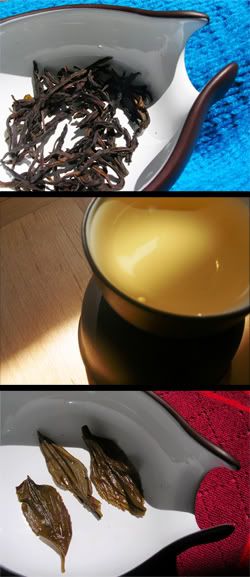Though probably with less Shaolin-inspired pouring (though I'm always happy to be proved wrong) and almost definitely with less 1950s pu'er (though I'd be really happy to be proved wrong in this regard!), we're putting on an informal, bijou meeting here today. Xiaomao, Tea Logic's VL, Iwii, and myself will be raising the pinmingbei in your honour - assuming that they can successfully navigate the medieval labyrinth which is Oxford.
Prior to all that, I've been enjoying some dancong kindly provided by CB (thanks!), which was bought from Royal Tea Garden. Listed on their web-site, it's the "second grade" variety.
Caledonian Springs @ 90C in 10cl dancong pot; ~4-5g leaf; 1 rinse
 Dry leaves:
Dry leaves:4-5cm dark, twisted strips. Generally dark, with oxidation varying down to some clear greens. The strong, familiar dancong aroma of peaches.
15s, 20s, 30s, 45s, 60s:
Yellow-green soup which looks rather Chablis - quite thin in colour. The wenxiangbei holds a very pleasant combination of two familiar scents that aren't usually present in the same cup: the peach beidixiang of conventional dancong, then the butter lengxiang of gaoshan tieguanyin.
The flavour, also, is an interesting hybrid: peach to open, then low (almost Wuyi yancha) roasted fruits. The process of roasting has been performed quite skillfully, as it is integrated well into the straight oxidation of this fairly spicy, buttery wulong leaf. The adjoinment is a touch clumsy, the gaps are evident, but it's very enjoyable.
As the infusions march on, the gaps get a little wider as the strain starts to show, with the various components going their separate ways. By the fifth infusion, we are down to the generic sourness of "tea".
Wet leaves:
Large and healthy - very green on the inside of each leaf, accounting for the buttery leaf-aroma and -taste.
Overall:
Good fun for the first two or three infusions. This is a decidedly inexpensive tea, and should be treated as such - in that regard, it performs very well in its class. A touch mundane as the infusions wear on, but it has already outperformed its grade. A fun little daily tea.

2 comments:
I personally feel all this wushu tea brewing maneuver (manoeuvre?) is, um, barmy :)
Anyways, is the tea being sold as "Dancong Shuixian"?
As far as I have been told by a knowledgable source who I trust in his knowledge of tea, and especially of Dancong, the *only* difference between a Fenghuang DC and a Fenghuang SX is that the former is sun dried, while the latter is not.
Therefore, it may be a misnomer to call a tea DC-SX. I think it's one or the other and can't be called both.
I must stress, however, that what I said above, per that friend, only applies to Fenghuang / Guangdong SX.
Wuyi SX is an entirely different story.
Roger that, thanks Andrew.
I think "shuixian" is used in the sense of "milanxiang" when used with dancong, though I'd welcome an opinion to the contrary. That is, like most dancong, it's named after a flower. I wonder if "shuixianxiang dancong" might be a more accurate description. Not one to lose sleep over, methinks. :)
Toodlepip,
Hobbes
Post a Comment